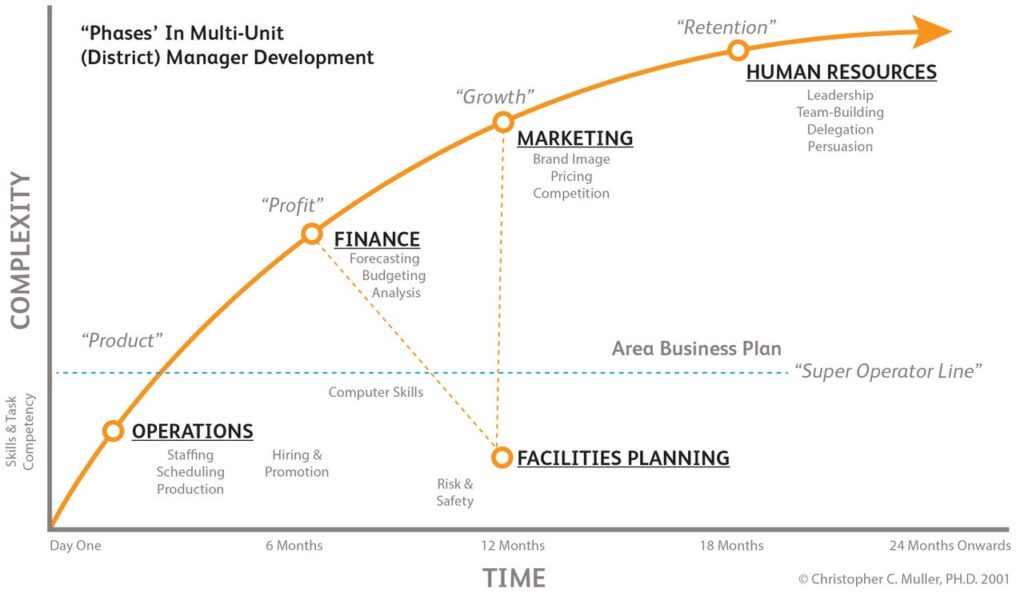
Within the hospitality and retail sector, multi-unit managers play a pivotal role in driving success across multiple locations. For over 40 years Professor Chris Muller has pioneered research into this critical role. His work identifying the phases of multi-unit management development, provides a clear framework for navigating the increasing complexity and time demands of this important role. In this blog, I share those phases with you, why it matters, and examples of excellence across each phase.
Phases in Multi-Unit Manager Development Model
This model helps managers progress from operational experts to strategic leaders capable of inspiring teams and delivering consistent results.

Here’s a summary of the five phases, including examples of how outstanding multi-unit managers excel, and practical development activities.
1/ Operations phase
At this foundational phase, multi-unit managers focus on ensuring operational consistency and excellence across locations.
Why it matters: consistency in service delivery and operational processes build the foundation for customer satisfaction and employee productivity.
Examples of excellence:
• Regularly reviewing KPIs like sales, customer satisfaction, and productivity to identify trends.
• Conducting structured site visits to ensure adherence to brand standards.
• Empowering site managers to implement best practices independently.
Development activity: review the site manager’s understanding of core operating brand standards, asking them to explain why they believe they matter, and how they build a culture of commitment amongst their team to consistently deliver them.
2/ Facilities planning phase
In this phase, managers shift focus to ensuring each site has the resources and infrastructure needed for seamless operations.
Why it matters: well-maintained facilities enhance customer experience, ensure compliance, and reduce costly repairs.
Examples of excellence:
• Developing a maintenance schedule to proactively address facility needs.
• Collaborating with contractors to implement eco-friendly upgrades.
• Conducting quarterly site audits to ensure brand standards are met.
Development activity: draft a facilities improvement plan, prioritising projects based on ROI and guest feedback by the end of the next quarter.
3/ Finance phase
Multi-unit managers begin to take a strategic approach to financial oversight, focusing on profitability and resource allocation.
Why it matters: understanding financial performance ensures efficient resource use and sustainable growth.
Examples of excellence:
• Analysing monthly profit and loss statements to identify cost-saving opportunities.
• Collaborating with finance teams to forecast budgets accurately.
• Coaching site managers on improving financial acumen.
Development activity: partner with the finance team to host a quarterly workshop for site managers on reading and interpreting financial reports.
4/ Marketing phase
The focus shifts to aligning unit-level operations with overarching brand and marketing strategies.
Why it matters: consistent messaging and effective local adaptations enhance brand equity and drive sales.
Examples of excellence:
• Supporting site managers in executing localised promotions that align with corporate campaigns.
• Monitoring social media to ensure positive guest interactions and leveraging feedback for improvement.
• Introducing loyalty programmes that reflect local customer preferences.
Development activity: organise a biannual meeting with the marketing team to brainstorm strategies tailored to each location’s demographics.
5/ Human resources phase
In the final phase, managers prioritise talent development and fostering a strong organisational culture.
Why it matters: high-performing teams drive exceptional customer experiences and operational success.
Examples of excellence:
• Implementing individual development plans for high-potential employees.
• Conducting biannual engagement surveys to address morale issues proactively.
• Establishing mentorship programmes to cultivate future leaders.
Development activity: set a goal to identify and develop at least two potential leaders per location over the next six months.
A key milestone: the super operator line
Prof. Muller identifies the ‘super operator line’ as a critical juncture. Many managers excel at single-unit operations but struggle to transition to multi-unit leadership, often micromanaging instead of delegating. Crossing this line requires trust, strategic thinking, and the ability to manage systems rather than individual tasks.
Why is this a transformative model?
The Phases of Multi-Unit Manager Development offers a roadmap for growth and operational excellence. By reflecting on their strengths and limitations in each phase, multi-unit managers can prioritise development activities and build a career defined by leadership and impact.


